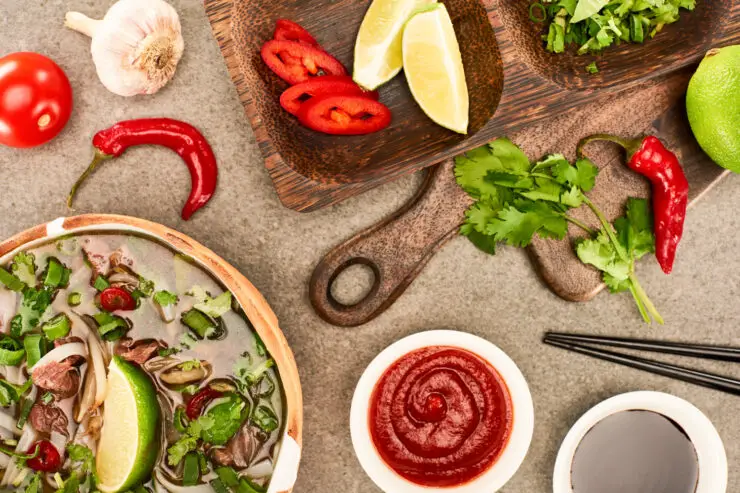As an Amazon Associate I earn from qualifying purchases. Please read the disclaimer for more info.
Diving into Vietnamese cuisine has been an incredible experience for me. The balance of flavors, textures, and the visual appeal of each dish consistently highlight the rich food culture of Vietnam. From the busy streets of Hanoi to the serene Mekong Delta, I’ve sampled a variety of dishes – each unique and enjoyable in its own way. In this Vietnamese Food Guide, I’m thrilled to share my journey through 45 popular Vietnamese dishes. Each of these authentic Vietnamese dishes are bursting with fresh ingredients and unique flavors, catering to a wide variety of tastes and preferences.
From iconic dishes like pho and banh mi to lesser-known regional specialties, Vietnamese cuisine has so much to offer. With its roots in traditional farming practices, Vietnamese cooking has evolved over time to embrace various influences, including French colonial rule and neighboring Asian countries. This fusion of flavors has resulted in a cuisine that is both unique and familiar, exotic and comforting.
Let’s delve into Vietnamese cuisine, appreciating its variety and unique tastes. We’ll explore Vietnamese starters, noodle dishes, rice-based meals, desserts, and key ingredients that define this cuisine. Prepare to broaden your food knowledge and learn more about Vietnamese dishes!
Key Takeaways
- Explore the flavorful world of traditional Vietnamese food with 30 dishes to try!
- Enjoy iconic dishes like Pho and Banh Mi, as well as delightful appetizers & snacks.
- Don’t miss out on unique ingredients & sauces that bring depth & freshness to traditional recipes.
Exploring Vietnamese Cuisine

Vietnamese food is renowned for its incredible balance. Fresh herbs and spices like lemongrass and ginger, along with cooling mint and fiery bird’s eye chili, are skillfully paired with proteins like minced pork and shrimp. This combination results in dishes that are as nutritious as they are gratifying. A standout feature of this cuisine is the use of fish sauce, which imparts a rich, umami depth to numerous dishes.
The influence of French colonial rule from 1887 to 1954 can be seen in many Vietnamese dishes, like the famous banh mi sandwich, which fuses Vietnamese flavors with a crusty French baguette. However, Vietnamese cuisine also has its own unique dishes, such as Cha Ca, a delectable fish dish from Hanoi, and Bun Rieu, a popular noodle soup made with crab, tomatoes, and tofu.
From the bustling street food scene of Ho Chi Minh City to the quaint eateries of Hanoi, Vietnam’s culinary landscape is diverse and exciting. Whether you’re sampling bite-sized steamed rice cakes (banh beo) or tucking into a hearty bowl of spicy beef noodle soup (bun bo hue), there’s no shortage of delicious experiences to be had.
Let’s dive straight into exploring Vietnamese dishes that you simply must try!
Iconic Vietnamese Dishes
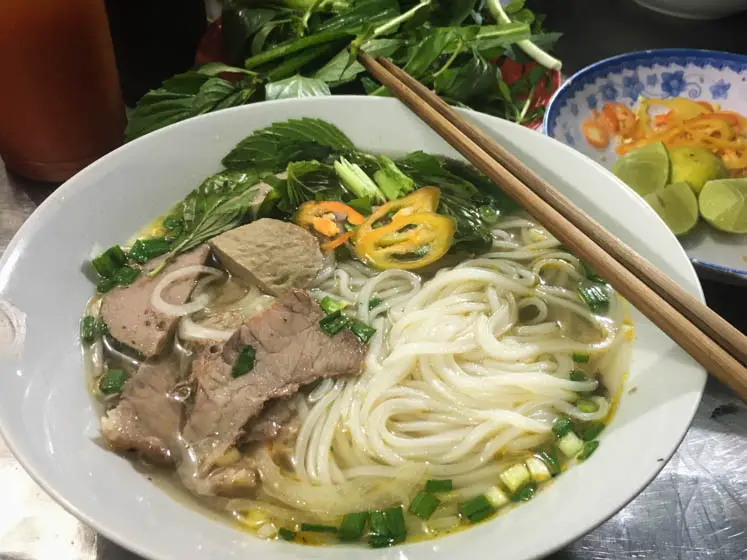
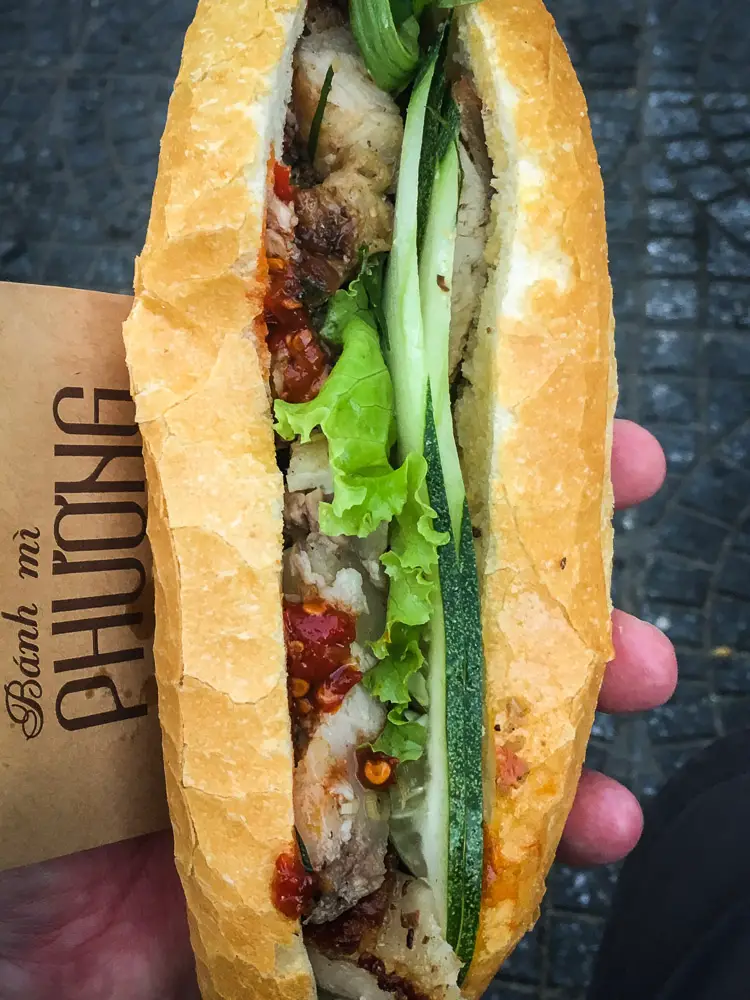
Pho and banh mi are the highlights of Vietnamese food, embodying a perfect blend of flavors, textures, and ingredients that make this cuisine unique. These popular Vietnamese dishes capture the distinctive tastes of Vietnam, from hearty noodle soups to delicious sandwiches filled with an array of ingredients.
Pho, the best known Vietnamese soup, is adored by both locals and tourists for its comforting broth, tender meat, and soft rice noodles. Meanwhile, banh mi, a sandwich with roots in French colonial times, combines the crunch of a fresh baguette with various meats, pickled veggies, and tasty sauces for a truly memorable flavor experience.”
Pho: The Quintessential Vietnamese Soup
Pho is a beloved Vietnamese dish that has captured the hearts and palates of people all around the world. This comforting noodle soup has a flavorful broth, rice noodles, meat, and fresh herbs, making it the perfect meal for any time of day.
The secret to pho’s deliciousness lies in its aromatic broth, which is often simmered for hours with star anise, clove, and cinnamon to achieve a delicate balance of natural sweetness and savory depth. Pho comes in various regional variations, with pho bac (northern pho) and pho Sai Gon (southern pho) being the most popular. Whether you prefer the chicken-based pho ga or the beefy goodness of pho bo, this iconic Vietnamese dish will warm your soul and satisfy your taste buds.
Some of the most famous pho restaurants in Vietnam include Pho Thin in Hanoi’s Hai Ba Trung District and Pho Hoa in Ho Chi Minh City’s District 3 on Pasteur Street. No trip to Vietnam would be complete without indulging in a steaming bowl of pho, so be sure to make this comforting dish a priority on your culinary journey!
Banh Mi: A Fusion of Flavors
Banh mi is another iconic Vietnamese dish that has gained international fame thanks to its delightful fusion of Vietnamese and French flavors. This delicious sandwich is made with a crusty baguette and filled with a variety of ingredients, including:
- Meats (such as grilled pork, chicken, beef, and pâté)
- Pickled vegetables (such as carrots and daikon radish)
- Fresh herbs (such as cilantro and mint)
- Flavorful sauces (such as mayonnaise, soy sauce, and chili sauce)
The banh mi’s origins can be traced back to the French colonial period in Vietnam when freshly baked baguettes were introduced to the local cuisine. The Vietnamese people soon began adding their own unique spin to the sandwich.
Banh mi is incredibly versatile, with countless variations and toppings to choose from. You can enjoy a classic banh mi with grilled pork, or try variations like a vegetarian version with tofu or fried egg.
Delightful Appetizers and Snacks
Vietnamese cuisine is celebrated for its snacks and appertizers like Goi cuon (fresh spring rolls) and banh beo (steamed rice cakes), which highlight fresh ingredients and distinctive textures. These light, palate-cleansing dishes, perfect for sharing, encapsulate the creativity of Vietnamese cooking.
Goi Cuon or Nem Cuon: Fresh Spring Rolls
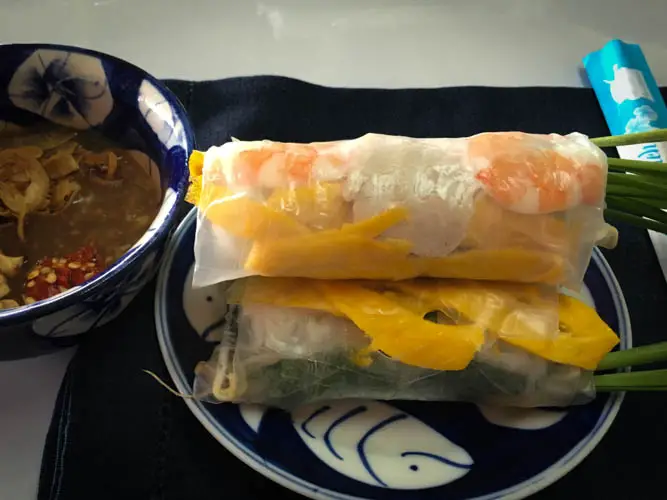
Gỏi cuốn or nem cuốn , also known as fresh spring rolls, is a healthy and refreshing Vietnamese appetizer that’s perfect for a light snack or a delicious start to a meal. These healthy rolls are made with the following ingredients to ensure a balance of flavours and textures.
- Tender rice noodles
- Protein sources such as shrimp, pork, and egg
- Fresh vegetables like lettuce, cucumber, and bean sprouts, and
- Herbs including mint, cilantro, and Thai basil.
All these components are delicately wrapped in in rice paper.
To enjoy goi cuon at their best, be sure to dip them into a tasty dipping sauce, such as hoisin or peanut sauce, which adds another layer of flavor and complexity to the dish.
Banh Beo: Steamed Rice Cakes
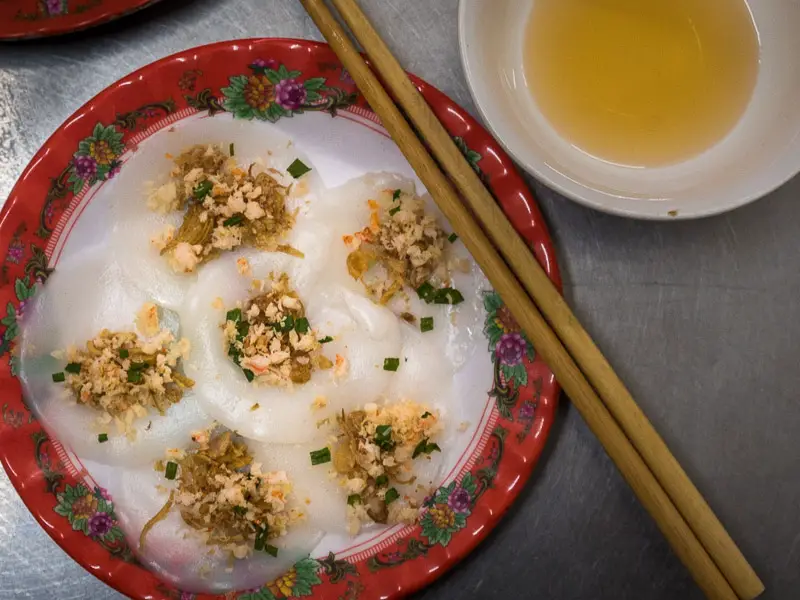
Banh beo is another delightful Vietnamese appetizer that showcases the creativity and resourcefulness of the country’s culinary traditions. These small steamed rice cakes are made from a batter of rice flour and tapioca flour and are typically topped with minced shrimp or a mixture of pork.
The unique texture of banh beo results from the combination of rice and tapioca flours, which creates a smooth and slightly chewy consistency that is both satisfying and enjoyable to eat. The savory toppings of minced shrimp or pork add depth and flavor to the dish, making it a popular choice for a light snack or appetizer.
Banh beo can be found at street food stalls and restaurants throughout Vietnam, especially in Hue, and they are often served with a flavorful dipping sauce like nuoc cham, which adds a tangy and spicy kick to the dish.
Banh Khot
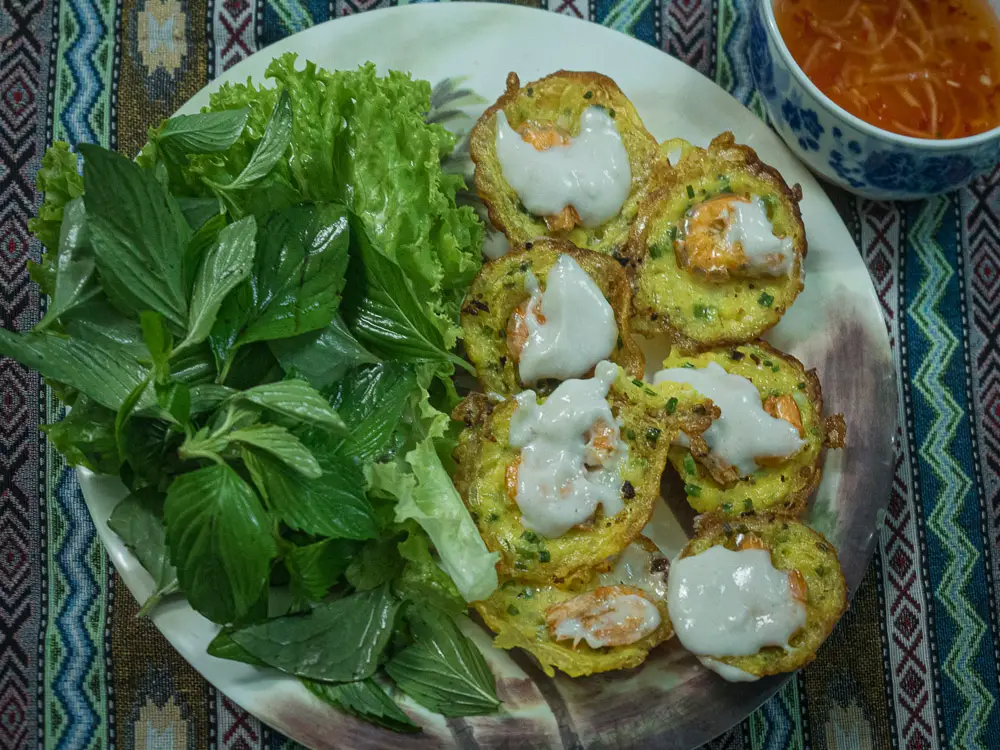
Banh Khot is a popular dish from southern Vietnam, commonly found in street markets and food stalls.
It’s essentially a small, crispy pancake made from rice flour, turmeric, and coconut milk. The pancake is topped with garlic and pepper-marinated shrimp, cooked until crunchy on the outside.
Making Banh Khot involves pouring batter into hot molds over an open flame, then topping it with shrimp.
The taste contrasts the crispy pancake with tender shrimp, the sweetness of the coconut milk batter complements the savory shrimp.
It’s usually served with fresh herbs like lettuce, mint, and perilla, and a tangy dipping sauce called Nuoc Cham.
Banh Cuon
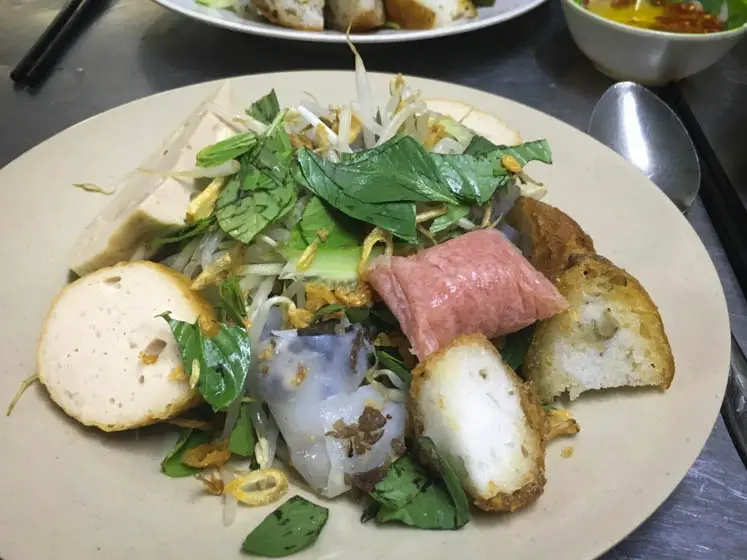
Banh Cuon is a popular dish from northern Vietnam and commonly eaten for breakfast. You can often find it in morning markets and roadside stalls.
The main component of Banh Cuon is its thin rice batter sheets. The batter, made from rice flour and water, is spread on a cloth steamer to create soft, translucent rolls.
These rolls are filled with ground pork and chopped wood ear mushrooms, seasoned with fish sauce, pepper, and shallots.
Making Banh Cuon is a careful process of individual steaming, filling, and rolling. It is fun to watch the vendor making the dish.
Banh Cuon has a unique taste. The thin rice rolls have a soft texture that complements the flavorful meat filling.
It’s usually served with fresh herbs, cucumber slices, bean sprouts, and Nuoc Cham, a tangy fish sauce.
Bo La Lot
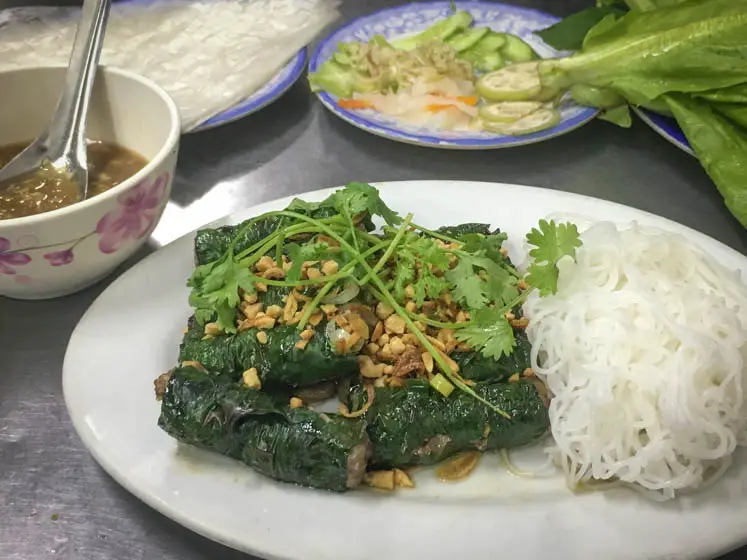
Bo La Lot is a traditional Vietnamese dish that is often served during large gatherings. The name “Bo La Lot” translates to “beef wrapped in betel leaf,” which succinctly describes the main components.
The primary ingredients for Bo La Lot are ground beef and betel leaves, also known as lolot leaves. Other essential ingredients include ground pork, pork fat, finely chopped lemongrass, and diced shallots. Some recipe variations may include garlic and other simple spices to add flavor.
Wrapped parcels are grilled over charcoal, which imbues the meat with a smoky flavor and causes the betel leaves to wilt slightly, releasing their unique aroma into the meat.
The result is a fragrant, flavorful dish that combines the meat’s savory taste with the betel leaves’ distinct flavor.
Banh Chung
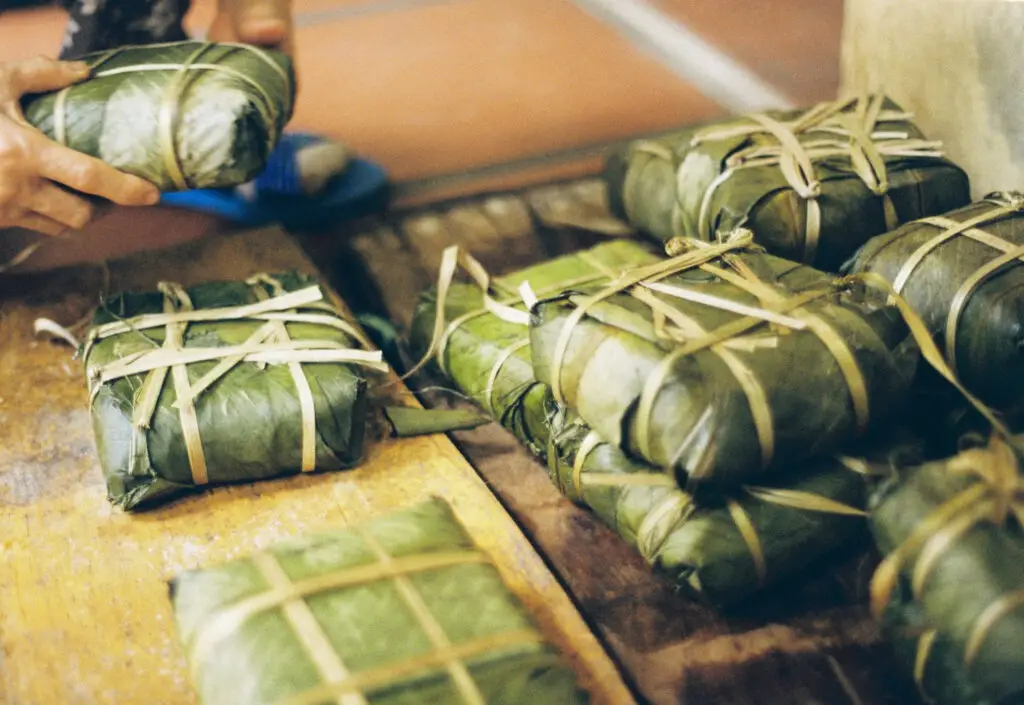
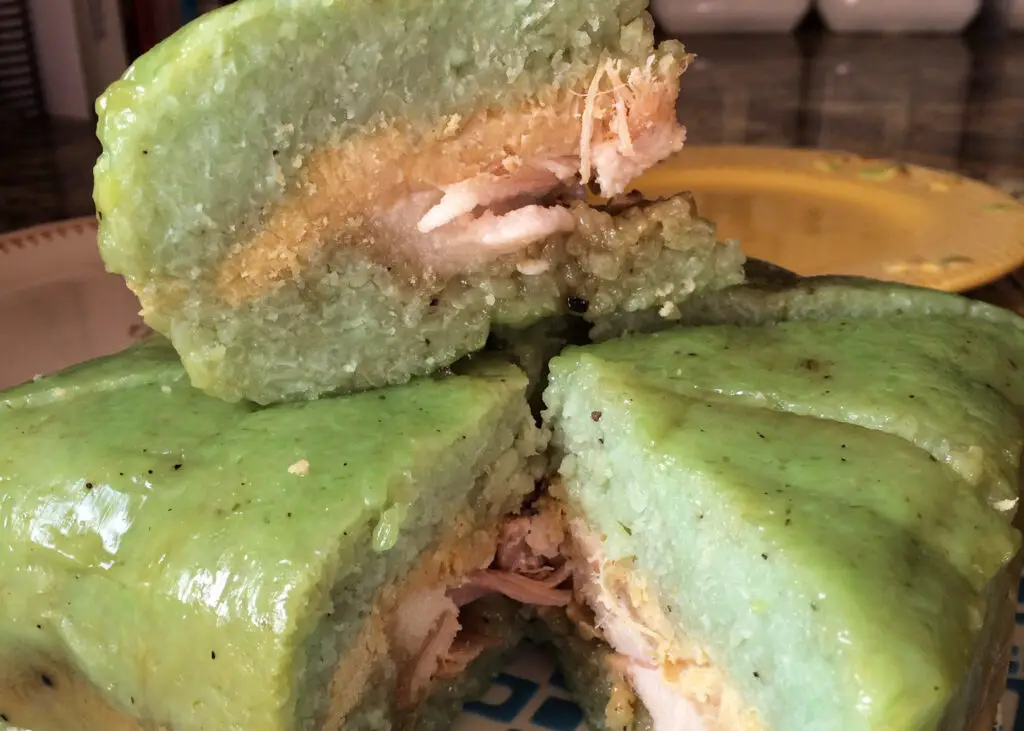
Banh Chung, a traditional Vietnamese rice cake with a distinctive square shape and deep green color, is a culinary symbol of Vietnam’s rich history and culture.
Its roots can be traced back to the Hong Bang Dynasty when Prince Lang Lieu invented it as an offering during Tet, the Vietnamese New Year.
The cake’s square form represents the Earth, reflecting Vietnam’s agricultural heritage, and its core ingredients of glutinous rice, mung beans, and pork symbolize the sky, plants, and animals, respectively.
The preparation of Banh Chung involves a meticulous process often involving family participation, thus making it not only food but also a catalyst for family bonding.
The ingredients are carefully layered on ‘dong’ leaves, wrapped tightly, and boiled for up to 12 hours to produce the compact cake. Beyond its role as a staple food, Banh Chung holds a special place in Vietnamese celebrations, including Tet and King Hung’s anniversary.
Sup Cua: Crab Soup
Hearty Noodle Dishes
Vietnamese cuisine is known for its hearty and satisfying noodle dishes, which showcase the regional diversity of flavors and ingredients found throughout the country. From the bold and spicy Bun Bo Hue to the unique and satisfying Cao Lau, these noodle dishes offer a taste of Vietnam that is both comforting and delicious.
With their rich broths, tender noodles, and flavorful toppings, these hearty noodle dishes are perfect for anyone looking to explore the depth and complexity of Vietnamese cuisine. Whether you’re a fan of the classic pho or looking to try something new, there’s a noodle dish out there that’s perfect for you.
Bun Bo Hue: Spicy Beef Noodle Soup
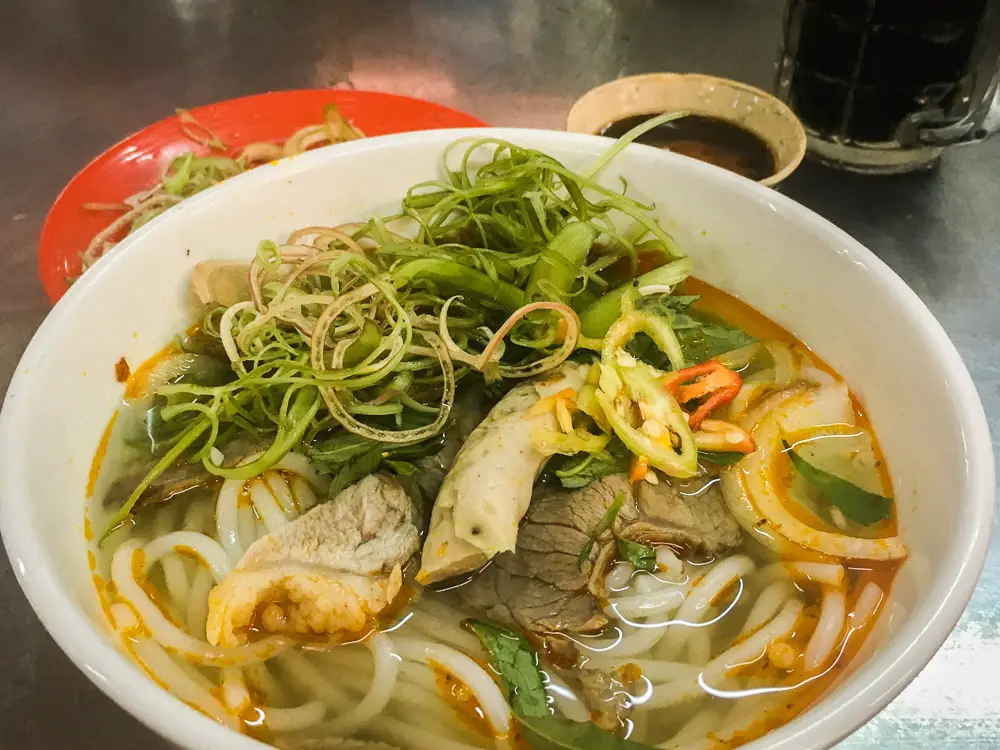
Hailing from central Vietnam, Bun Bo Hue is a spicy beef and pork noodle soup that is sure to tantalize your taste buds and warm your soul. This dish is a local favorite due to its intense and enticing flavor. The broth is made from a savory combination of:
- pork and beef bones
- lemongrass
- fermented shrimp paste
- annatto
- sugar
- chili oil
The round rice noodles used in Bun Bo Hue have a satisfyingly chewy texture that perfectly complements the tender meat and fragrant broth. Fresh herbs and vegetables, such as bean sprouts and lime, can be added to the dish to provide a refreshing contrast to the spicy and savory flavors of the soup.
Bun Bo Hue is a must-try for anyone looking to experience the bold flavors and regional diversity of Vietnamese cuisine.
Cao Lau: Hoi An’s Signature Dish
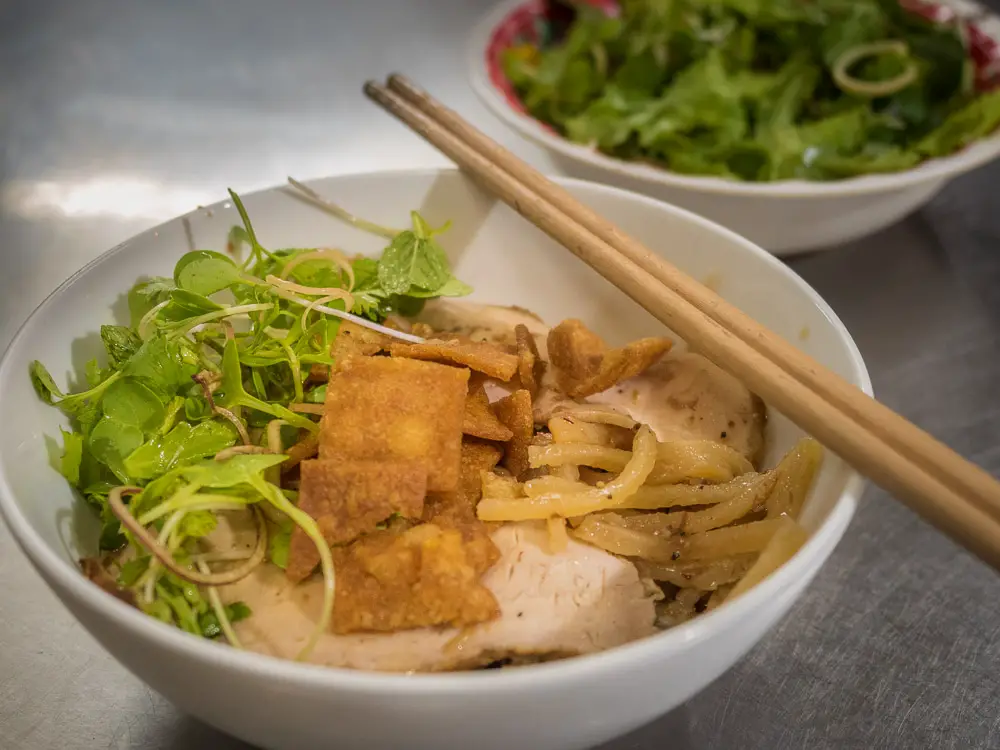
Cao Lau is a signature dish from the ancient town of Hoi An, known for its unique combination of thick noodles, succulent pork, and fresh herbs. This mouthwatering dish showcases the fusion of Japanese, Chinese, and Vietnamese influences that have shaped Hoi An’s culinary landscape.
The secret to Cao Lau’s unique texture and flavor lies in the water used to make the noodles. It is said that only water from the Ba Le Well, a local well known for its alkaline water, can produce the authentic taste that has made Cao Lau a beloved dish in Hoi An.
With its thick noodles, tender pork, and fresh herbs, this dish is a delicious testament to the rich history and diverse influences of Vietnamese cuisine.
Bun Cha
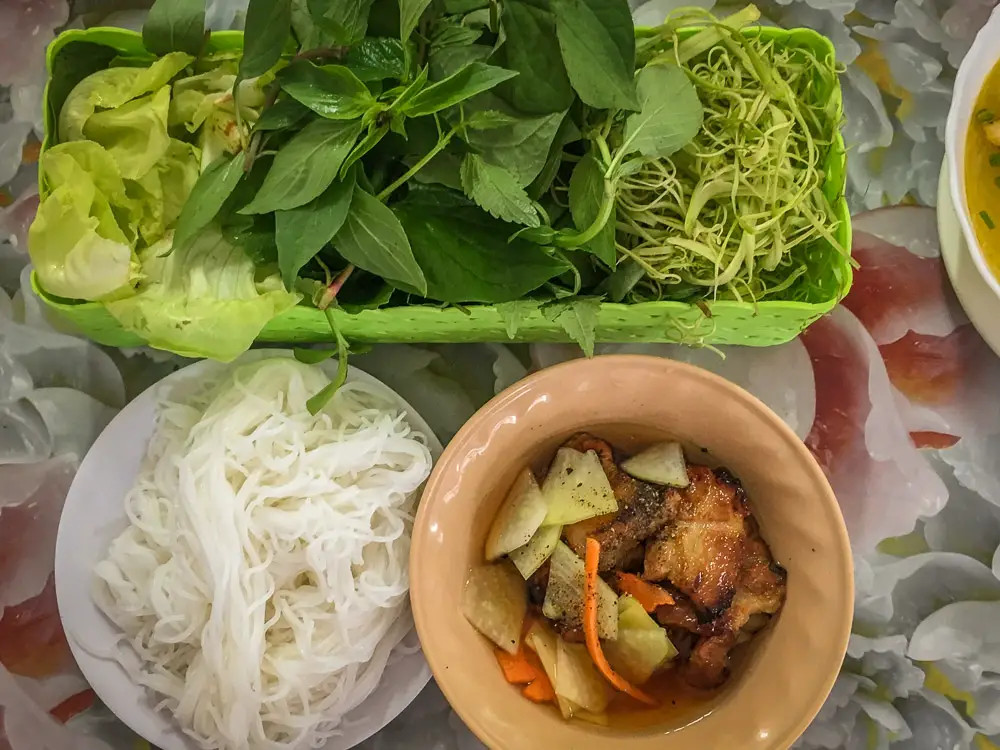
Bun Cha Hanoi is a popular Vietnamese dish traditionally associated with the capital city, Hanoi. This delectable street food is a beloved lunchtime favorite and has gained international recognition.
The dish consists of grilled pork served in a tangy broth, accompanied by rice vermicelli noodles (bun) and fresh herbs. The pork, often a mix of minced pork patties (cha vien) and slices of pork belly, is marinated in a mixture of fish sauce, sugar, and garlic before being grilled over charcoal. This results in succulent, smoky pieces of meat that are slightly caramelized on the outside.
The broth, or “dipping sauce,” is another crucial component of Bun Cha Hanoi. It’s a delicate balance of sweet, sour, and salty flavors, achieved by combining fish sauce, vinegar, sugar, and water, along with slices of pickled green papaya and carrot for a crunchy contrast.
To eat Bun Cha Hanoi, you take a piece of pork, dip it into the broth, and eat it with the bun and herbs. The freshness of the herbs and the softness of the noodles perfectly complement the rich, savory pork and tangy broth, creating a harmonious blend of flavors that is characteristic of Vietnamese cuisine.
Bun Banh Tam / Banh Tam Bi
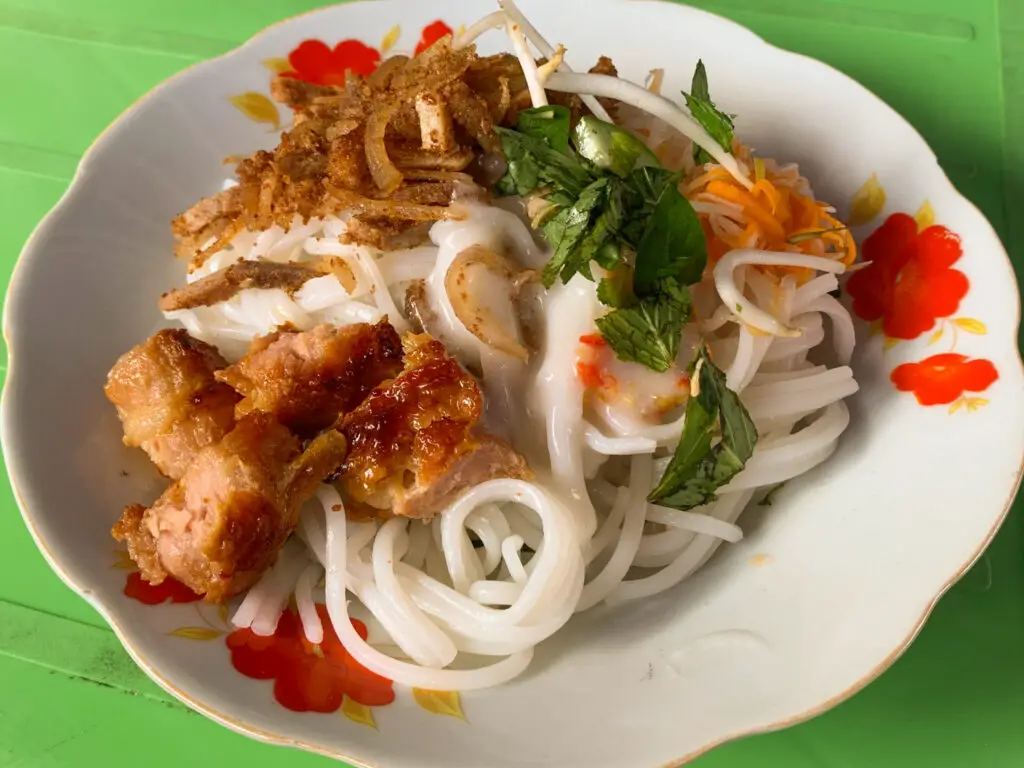
Bun Banh Tam, or Banh Tam Bi, is a special noodle dish hailing from the Mekong Delta in southern Vietnam. Its signature element is its thick rice and tapioca noodles that give it a unique texture and feel.
It has become a favourite breakfast dish each time I visit Cho Nha Man, the local market in the town of Nha Man, close to our Mekong Delta home.
These noodles are usually paired with various herbs and pork, and then soaked in a luscious coconut milk sauce, creating a rich and indulgent flavor blend. The pork, which can include Vietnamese pork roll and shredded pork skin, adds a savory depth to the dish’s taste.
Adding to the mix, Bun Banh Tam often comes topped with pickled vegetables like green papaya and carrot, toasted peanuts, and fresh Thai basil. These additions offer a refreshing counterpoint to the rich coconut milk and pork, enhancing the dish’s layered flavors and balance.
What sets Bun Banh Tam apart from other Vietnamese noodle dishes is its use of coconut milk, making it a unique culinary delight. It’s a versatile dish that can be enjoyed as a substantial lunch, a full meal, or a satisfying breakfast.
Bun Rieu
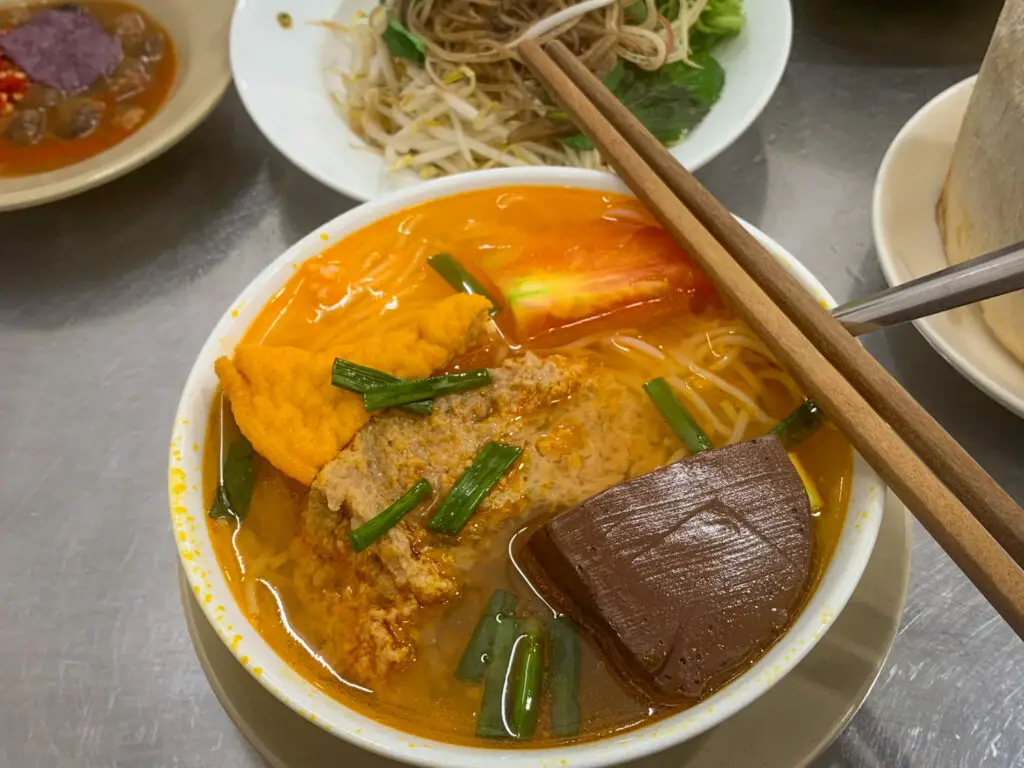
Bun Rieu is a traditional Vietnamese noodle soup. It’s typically made with rice vermicelli, fresh water crab paste, tomatoes, and tofu.
The broth of Bun Rieu is tangy and slightly sweet, thanks to the tomatoes and crab paste.
The soup often includes other ingredients like blood cubes, fried tofu, and sometimes snails. It’s usually served with a plate of fresh herbs like perilla, mint, water spinach and banana blossom.
A key characteristic of Bun Rieu is its bright red color, which comes from annatto seeds. The dish is served with lime wedges, chili, and shrimp paste on the side, allowing each person to adjust the flavor to their liking.
Bun Bo Nam Bo
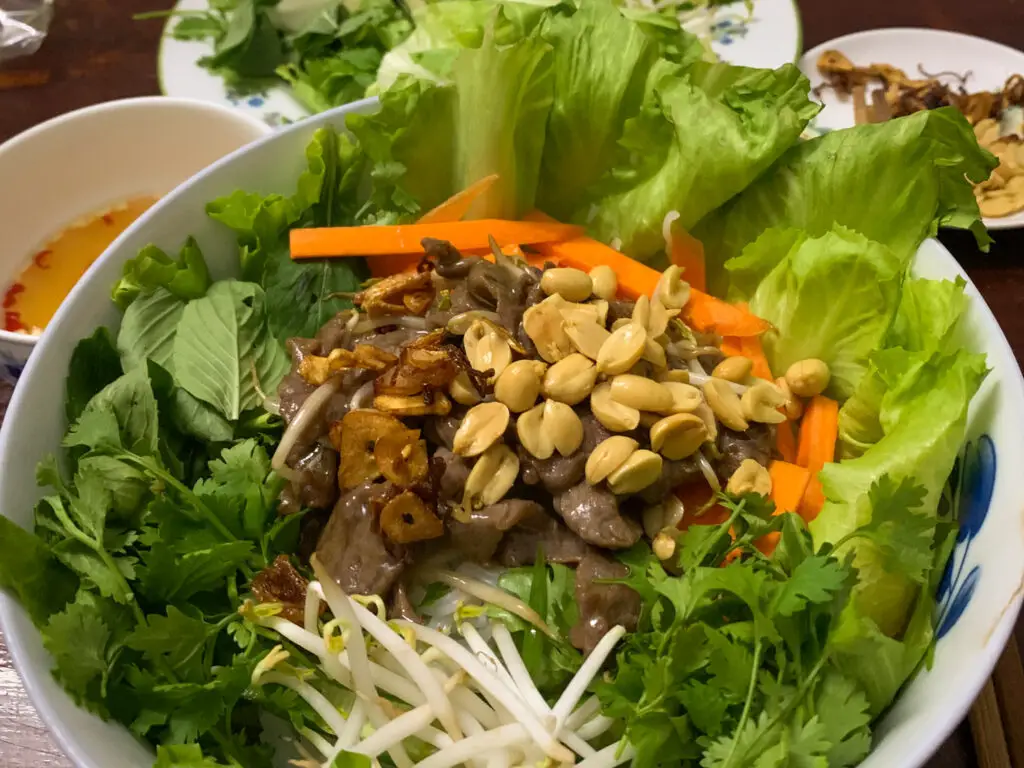
Bun Bo Nam Bo, a popular dish from southern Vietnam, is a flavorful and satisfying noodle salad. It features tender stir-fried beef marinated in garlic, lemongrass, and fish sauce, served atop a bed of fresh rice vermicelli noodles.
The dish is garnished with various herbs such as mint, basil, cilantro, crunchy peanuts, and crispy fried shallots.
A tangy, sweet, and savory nuoc cham dressing, made from lime juice, sugar, garlic, and fish sauce, is poured over the top to meld all the flavors together.
Mi Quang
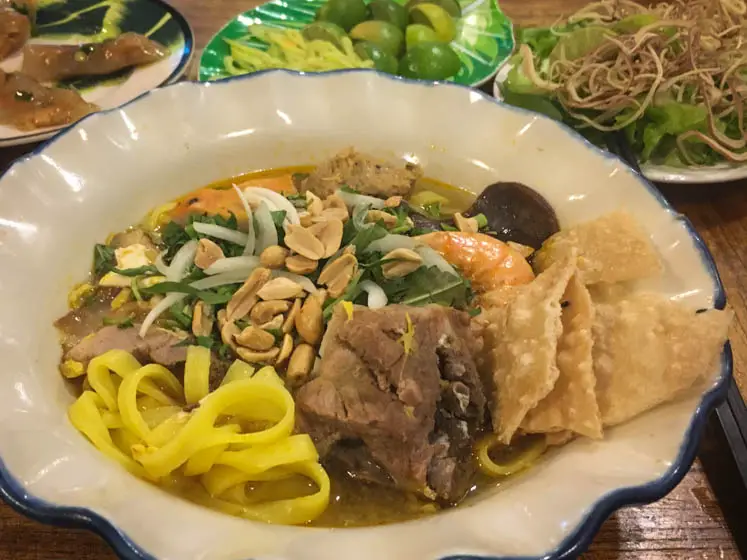
Mì Quảng is a vibrant and flavorful noodle dish that hails from the Quang Nam province of Vietnam. It is a popular dish in the historic town of Hoi An.
It features flat rice noodles topped with a medley of ingredients such as seasoned pork, shrimp, hard-boiled eggs, and sometimes chicken or beef. Fresh herbs, crushed peanuts, crispy rice crackers, and a spoonful of hot chili paste for an added kick are mixed in.
What sets Mì Quảng apart is the minimal amount of broth used, just enough to barely cover the noodles, making it more like a noodle salad than a soup.
When visiting Hoi An, tasting Mì Quảng is a must, as it offers a unique culinary experience that encapsulates the region’s distinct tastes and flavors.
- Banh Canh Cua
Flavorful Rice Creations
Rice is a staple ingredient in Vietnamese cuisine, and its versatility has given rise to a diverse range of delicious dishes that celebrate the humble grain. From Com Tam, made with broken rice and grilled pork, to Xoi, a traditional sticky rice dish served sweet or savory, there’s a flavorful rice creation to suit any palate.
These enticing rice dishes exemplify the ingenuity of Vietnamese cuisine, demonstrating how basic ingredients can be elevated into delightful and fulfilling meals. Now, let’s delve into these savory rice specialties to uncover their unique appeal.
Com Tam: Broken Rice with Grilled Pork
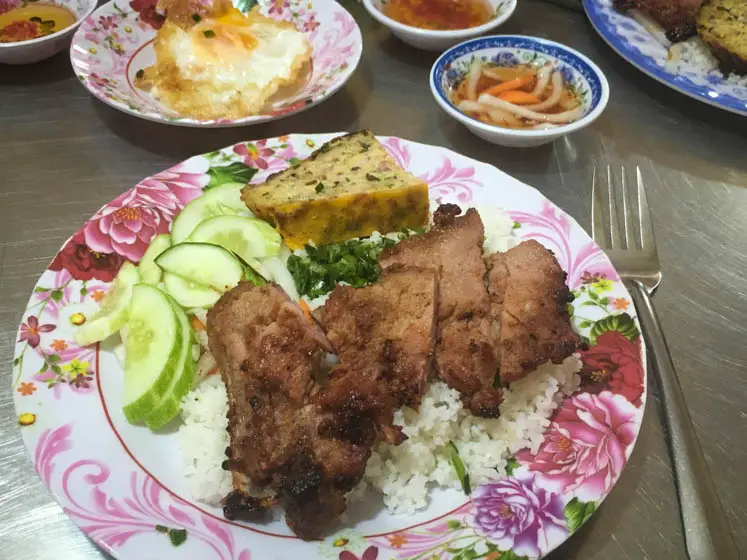
Com Tam is a popular Vietnamese dish made with broken rice, which are fractured rice grains that were once considered a budget-friendly option due to their lower cost. Today, Com Tam is celebrated for its delicious combination of flavors and textures, featuring:
- Grilled pork or thit nuong
- Egg meatloaf and/or fried egg
- Pickled vegetables
- Other accompaniments
The resourcefulness and creativity of Vietnamese cooking are beautifully showcased in Com Tam, transforming humble, broken rice grains into a satisfying and flavorful meal.
Com Hen
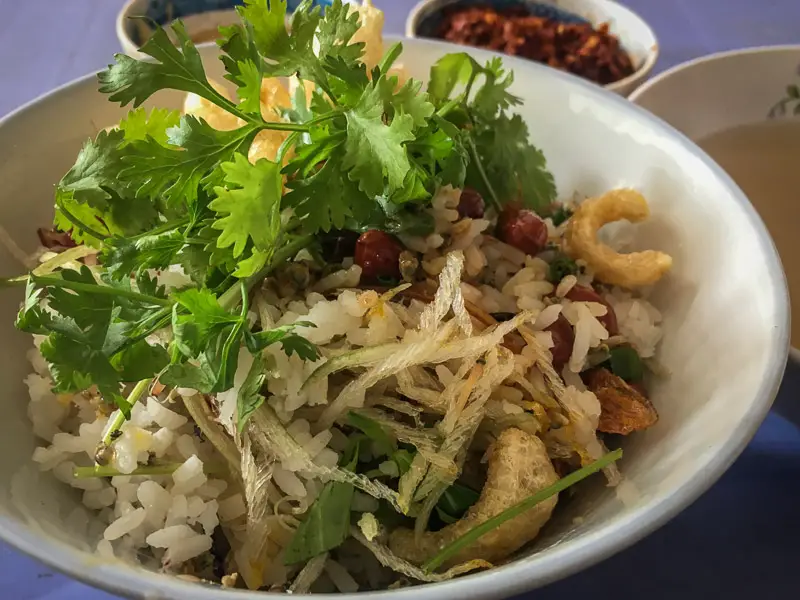
Com Hen, also known as Hue Clam Rice, is a specialty dish from Hue in Central Vietnam. This dish is a delightful medley of flavors and textures, combining several ingredients in one bowl. The main components include rice and basket clams (hen), which give the dish its name.
However, Com Hen is not just about rice and clams. It also includes fried pork skin, adding a crunchy texture to the dish. Fresh herbs like basil contribute a fragrant aroma, while chili adds a spicy kick. Roasted peanuts are often sprinkled on top for an extra crunch, and the dish is typically dressed with annatto oil, lending it a vibrant color and a unique flavor.
Xoi: Sticky Rice Delights
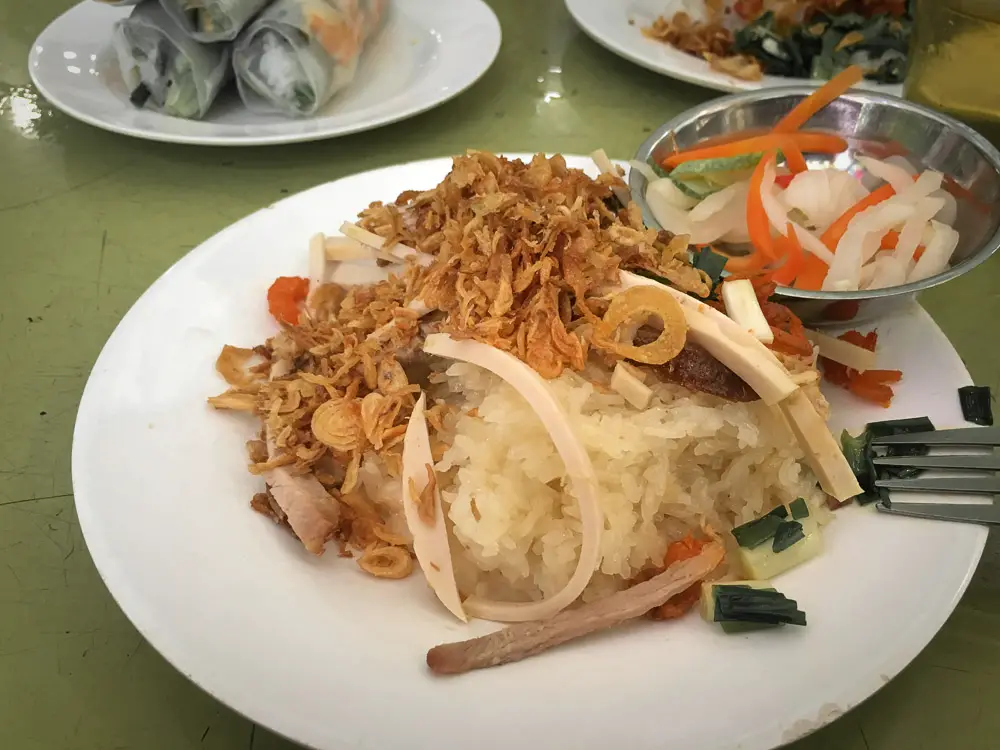
Xoi is a traditional Vietnamese dish made with sticky rice, which is soaked, drained, and steamed to create a delicious and versatile base for various toppings and flavors. Xoi can be served sweet (xoi ngot) or savory (xoi man), making it a popular choice for breakfast, dessert, or a satisfying snack.
Sweet xoi is often made with ingredients like coconut, sugar, and fruit, while savory xoi may feature toppings such as pork, chicken, shrimp, mushrooms, and vegetables. The sticky rice itself can be flavored with herbs, spices, and sauces, adding depth and complexity to the dish.
Chao – Rice porridge
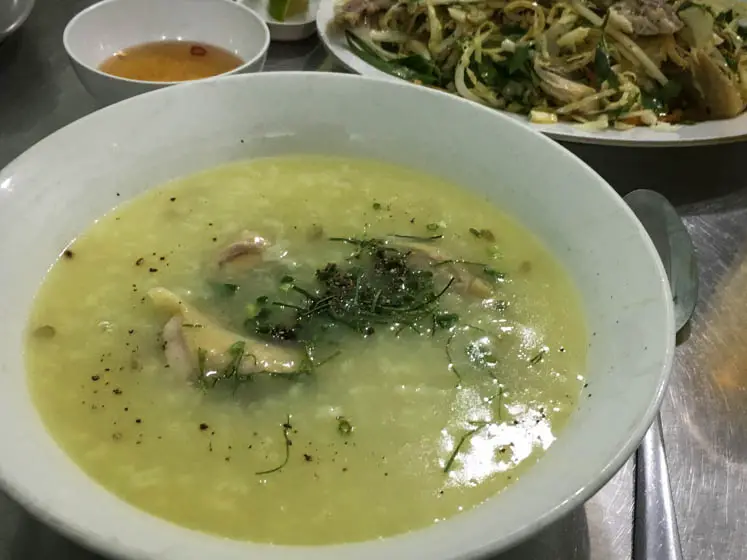
Chao is a comforting rice porridge that’s made by boiling rice in water or stock until it breaks down and thickens into a creamy consistency.
It’s often served with condiments such as herbs, diced chilies, and fish sauce to add flavor. Chao is simple yet versatile, making it a popular dish that can be enjoyed for breakfast or as a snack.
Specialty Dishes
Vietnam’s culinary landscape is diverse, with each region boasting its own specialty dishes. Each regional cuisine tells a story about the local natural resources, historical influences, and cultural traditions.
Cha Ca La Vong
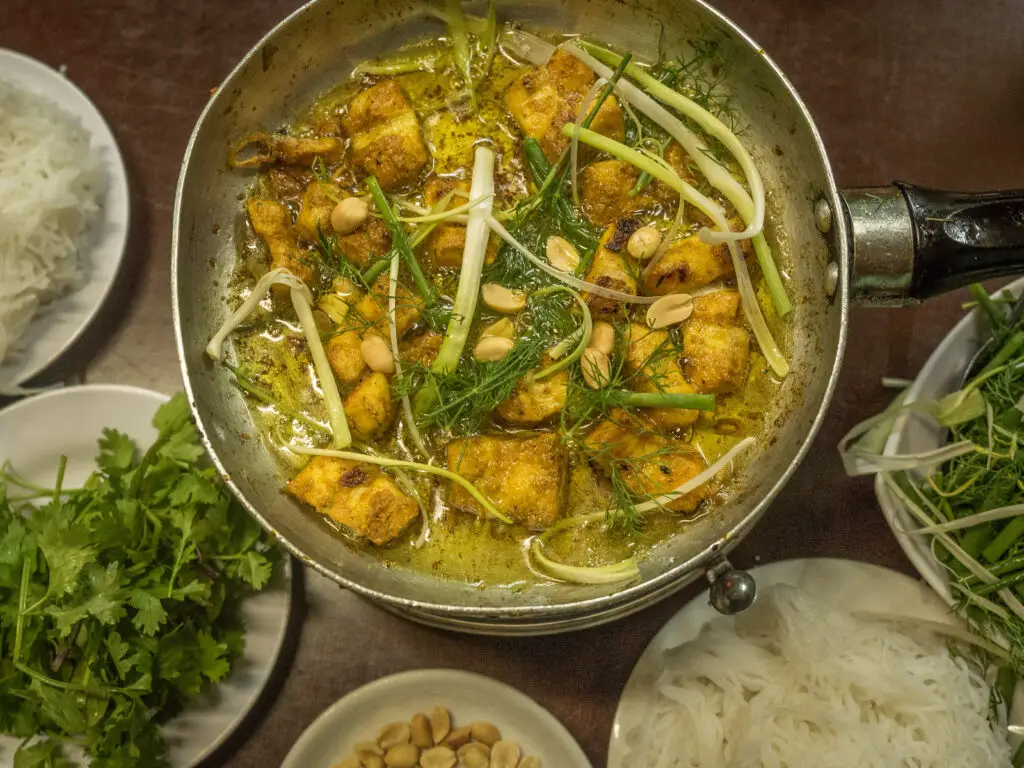
Cha Ca La Vong is a renowned Vietnamese dish that hails from Hanoi, the capital city of Vietnam. This dish is so iconic that there’s even a street named after it in Hanoi – Cha Ca Street.
The star of this dish is grilled fish, traditionally a type of catfish, marinated in turmeric and galangal, giving it a distinctive yellow color and an aromatic flavor. The marinated fish is first grilled over charcoal, then sautéed at the table in a sizzling pan with dill, scallions, and a generous amount of oil.
What makes Cha Ca La Vong unique is not just the flavorful fish, but also the accompaniments. It is typically served with a bowl of white rice noodles, known as bun, fresh herbs like mint and cilantro, peanuts, and a fermented shrimp paste sauce called Mam Tom, which adds a salty, umami punch.
- Goat in Ninh Binh
- Horse Stew in North Vietnam
Bun Quay Phu Quốc
Bun Quay Phu Quoc is a Vietnamese dish from Phu Quoc island. It features homemade fish cakes made from a paste of fresh fish, shallots, pepper, and fish sauce.
The paste is flattened, cut into pieces, and cooked in broth, resulting in firm, flavorful fish cakes. The dish also includes a sweet sauce made from condensed milk, sugar, minced garlic, and chilli.
This sauce, served on the side for dipping, contrasts with the salty fish cakes and broth.
The dish is completed with rice vermicelli noodles and various herbs and vegetables.
Bun Quay Phu Quoc is a testament to Vietnam’s culinary creativity, combining traditional techniques with unexpected flavors to create a dish that is both comforting and surprising.
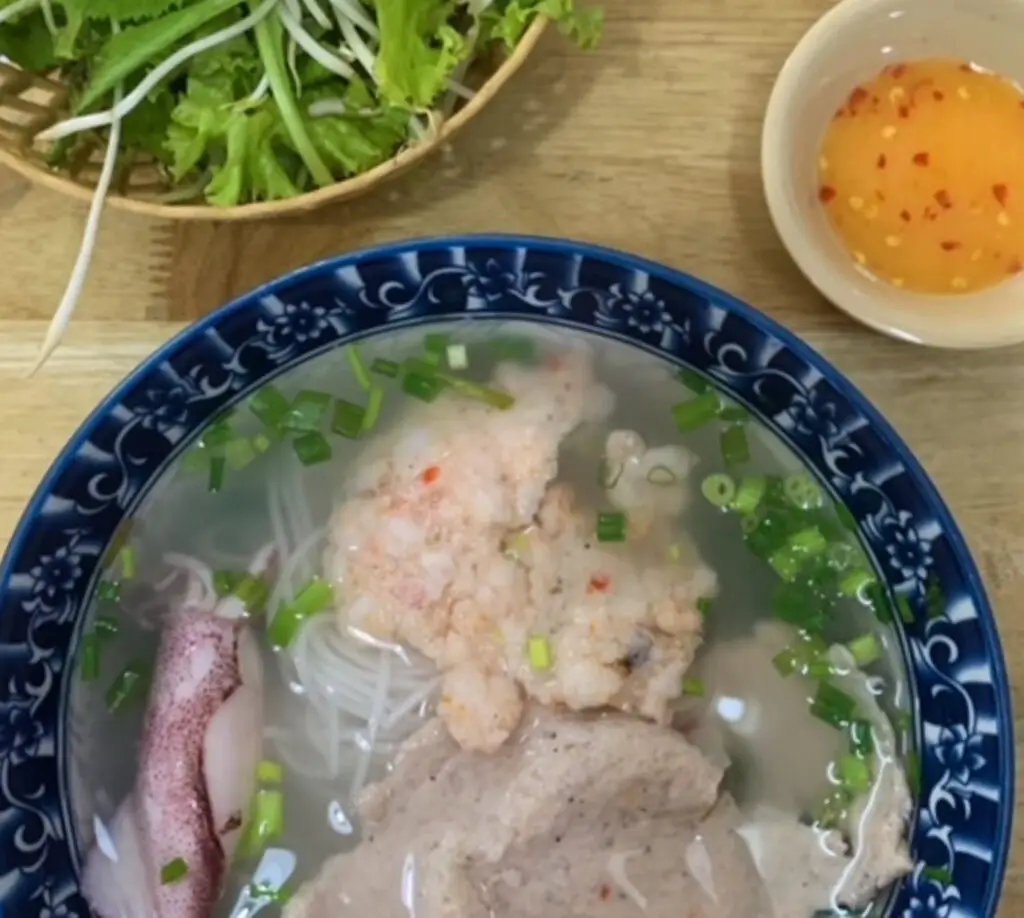
Delectable Desserts and Beverages
After indulging in the savory delights of Vietnamese cuisine, it’s time to treat yourself to some of the country’s delectable desserts and refreshing beverages. Vietnamese desserts like Che and beverages such as Ca Phe Trung offer a sweet and satisfying end to any meal, with unique ingredients and preparations that showcase the creativity and diversity of the cuisine.
From sweet soups and puddings to rich and indulgent coffee concoctions, the world of Vietnamese desserts and beverages is as diverse and flavorful as the cuisine itself. Let’s venture into these sweet delicacies and find the ideal way to satiate your sweet cravings and refresh yourself.
Che: Sweet Soups and Puddings
Che is a popular Vietnamese dessert category that encompasses a wide range of sweet soups and puddings, made with a variety of ingredients and served either hot or cold. These delightful treats are a testament to the creativity and resourcefulness of Vietnamese cuisine, showcasing the country’s love for sweet, refreshing, and satisfying desserts.
Some examples of Che include three-color dessert (che ba mau), sweet corn pudding (che bap), sweet mung bean soup (che dau xanh), and sweet black sesame soup (xi ma). These desserts often feature ingredients like beans, fruits, jellies, and tapioca, which are combined with water or coconut milk and sweetened with sugar or honey. The result is a delicious and satisfying dessert that is perfect for enjoying after a meal or as a refreshing snack on a hot day.
Whether you prefer your Che hot or cold, sweet or savory, there’s a delicious dessert waiting for you to discover. Be sure to sample some of these sweet soups and puddings on your journey through Vietnamese cuisine and experience the delightful flavors of this unique dessert category.
Ca Phe Trung: Egg Coffee
Ca Phe Trung, or Vietnamese egg coffee, is a unique and indulgent beverage that has become increasingly popular in recent years. This rich and creamy concoction is made by beating an egg yolk with sweetened condensed milk and combining it with freshly brewed Vietnamese coffee. The result is a luxurious and velvety drink that offers a delicious contrast between the strong and bold flavors of the coffee and the sweet, creamy richness of the egg and condensed milk mixture.
Ca Phe Trung may not be your typical cup of coffee, but it’s a delightful and decadent treat that coffee lovers and dessert enthusiasts alike will enjoy. Ca Phe Trung was invented in Hanoi during the 1940s as a creative solution to the milk shortage that occurred during this time.
Today, it’s a beloved Vietnamese beverage that can be found in cafes and restaurants throughout the country. So, if you’re looking for a unique and satisfying way to enjoy your coffee with a sweet twist, be sure to give Ca Phe Trung a try!
Essential Vietnamese Ingredients and Sauces
Vietnamese cuisine is known for its depth and complexity, which is largely due to the essential ingredients and sauces that are used to create its distinctive flavors. Fish sauce and lemongrass are two such ingredients that play a crucial role in Vietnamese cooking, adding depth, complexity, and freshness to various dishes.
From the savory umami of fish sauce to the zesty citrus notes of lemongrass, these essential ingredients and sauces are the backbone of Vietnamese cuisine. Let’s examine these pivotal elements more closely and uncover the enchantment they infuse into our favorite dishes.
Fish Sauce: The Soul of Vietnamese Cooking
Fish sauce is a vital ingredient in Vietnamese cooking, providing a rich and savory umami flavor to a wide range of dishes. Made from fermented fish and salt, fish sauce is an indispensable condiment that is used to season, marinate, and enhance the flavors of Vietnamese cuisine.
As a key ingredient in Vietnamese cooking, fish sauce is used in various dishes, from soups and stews to salads and dipping sauces. Its unique flavor adds depth and complexity to dishes, making it an essential component in the culinary repertoire of any Vietnamese chef.
Whether you’re enjoying a bowl of pho, a plate of grilled pork, or a refreshing salad, the distinctive taste of fish sauce will surely be present, adding a delicious umami note to your meal.
So, the next time you savor a Vietnamese dish, take a moment to appreciate the magic of fish sauce and its crucial role in the flavors of Vietnamese cuisine.
Muot Ot – Chili Salt
Muối Ớt, also known as Vietnamese Chili Salt, is a vibrant, spicy mix that’s a staple in Vietnam’s culinary scene. It’s a simple yet potent blend that combines the fiery heat of chili peppers with the sharp tang of salt, creating a unique flavor that adds a kick to any dish.
This versatile seasoning is traditionally used as a dipping salt for fruits, offering a combination of spicy, salty, and citrusy elements that enhance the natural sweetness of the fruit.
The preparation of Muối Ớt involves pounding birdseye chili and salt together, resulting in a bright, flavorful condiment. Whether you’re adding it to your favorite tropical fruits or using it as a seasoning for vegetables, Muối Ớt is a delicious and addictive addition to any meal.
Lemongrass: Aromatic Herb
Lemongrass is another essential ingredient in Vietnamese cuisine, adding a fresh and citrusy note to various dishes. This aromatic herb is native to Southeast Asia and is often used in Vietnamese cooking to provide a subtle hint of lemony flavor and a delightful fragrance.
Used in soups, curries, stir-fries, and even sauces, lemongrass is a versatile herb that brings a burst of freshness to any dish it’s added to. Its zesty and slightly gingery taste complements the other flavors in Vietnamese cuisine, making it a popular choice for chefs and home cooks alike.
In addition to its culinary uses, lemongrass is also prized for its health benefits, which include antioxidant and anti-inflammatory properties, as well as its ability to aid digestion and reduce stress.
So, the next time you enjoy a Vietnamese meal, take note of the fragrant aroma and zesty flavor of lemongrass and appreciate the many ways this aromatic herb enhances the dishes you love.
Summary
As we’ve journeyed through the diverse and delicious world of Vietnamese cuisine, it’s clear that this culinary tradition offers a wealth of flavors, textures, and ingredients to explore and savor. From the comforting warmth of pho to the delicate balance of flavors in a banh mi sandwich, Vietnamese dishes showcase the creativity and resourcefulness of the country’s culinary heritage.
We’ve also discovered the essential ingredients and sauces that form the backbone of Vietnamese cuisine, like fish sauce and lemongrass, which add depth, complexity, and freshness to various dishes. These key components are a testament to the skill and artistry of Vietnamese chefs, who expertly combine flavors and textures to create dishes that are both delicious and satisfying.
In conclusion, Vietnamese cuisine is a rich and vibrant culinary tradition that will delight and inspire anyone who experiences it. With its unique fusion of flavors, fresh ingredients, and diverse regional influences, there’s no better time to embark on your own culinary adventure through the amazing world of Vietnamese food. So, why not start today and discover the incredible dishes and flavors that await you?
Frequently Asked Questions
What are typical Vietnamese foods?
Traditional Vietnamese food uses fish sauce, herbs such as mint and cilantro, meats like pork and beef, chicken, and seafood, often combined with noodles, rice, and tropical fruits. Popular dishes include pho, bun cha, and rice paper rolls.
What is the most traditional Vietnamese dish?
The most traditional Vietnamese dish is Pho, a noodle soup made with flat rice noodles, a hearty beef stock, and slivers of beef or boiled chicken. Originating just outside Hanoi in the early 20th century, this comforting dish is enjoyed by people worldwide and can be customized with sauces, herbs, and spices to suit any taste.
What are 5 popular street foods in Vietnam?
Vietnam is known for its amazing street food, which includes Banh Xeo (Vietnamese Filled Pancakes), Banh Tranh Nuong (Vietnamese Grilled Pizza), Bun Cha (Rice Noodle Soup With Grilled Pork), Ph (Flat Rice Noodle Soup With Beef) and Bánh M (Filled Baguette). These five dishes are a must-try for anyone looking to taste the country’s mouth-watering flavors.
What are some of the key ingredients in Vietnamese cuisine?
Fresh herbs and vegetables like lemongrass, ginger, mint, and bird’s eye chili are staples in Vietnamese cuisine, alongside proteins such as minced pork and shrimp. Fish sauce is a key ingredient that adds depth of flavor to many dishes.
How do Vietnamese desserts and beverages differ from those in other cuisines?
Vietnamese desserts and beverages feature unique ingredients and preparations, providing a distinctively sweet and refreshing experience compared to other cuisines.

